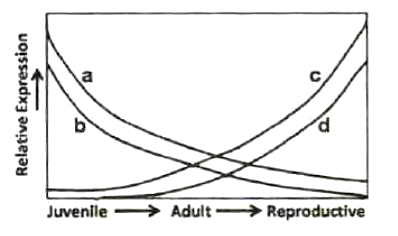 Multiple Choice Questions
Multiple Choice QuestionsThe presence of β-catenin in the nuclei of blastomeres in the dorsal portion of the amphibian embryo is one of the determinants for laying down the dorso-ventral axis. What will be the outcome of expressing a dominant negative form of GSK3 in the ventral cells of early embryo?
The dorsal cells will be ventralized.
A second axis will be formed.
The primary organizer will not be formed.
The embryo will develop normally.
B.
A second axis will be formed.
The outcome of expressing a dominant-negative form of GSK3 in the ventral cells of the early embryo is a second axis will not be formed.
Extensive molecular genetic studies on miR156, miR172, SPLgenes and AP2-like genes have yielded the following functional model on the juvenile → adult → reproductive transition in Arabidopsis:

Based on these results, the following schematic diagram has been proposed to predict the expression kinetics of these genetic factors:

Which of the following combinations is most likely to be correct?
a - miR156; b - SPL genes; c - miR172; d - AP2 like genes
a - miR156; b - miR172; c - SPL genes; d - AP2 like genes
a - miR172; b - SPL genes; c - AP2 like genes; d - miR156
a - miR156; b - AP2 like genes; c - miR172; d - SPL genes
Injection of Noggin mRNA in cells that will become the future ventral side of a frog embryo mimics the effect of an organizer graft to the ventral side.This experiment demonstrates that
A. Noggin is a transcription factor.
B. Noggin induces ventral fates.
C. Noggin is involved in organizer fate.
D. Noggin is required to induce secondary axis.
Which one of the following options represents correct combination of statement(s)?
A and C
C and D
A and B
B and C
Antennapedia complex in Drosophila contain five genes, lab, pb, dfd, scr, and Antp and they express in parasegments 1to 5, respectively in a non-overlapping manner. In the larva or in later stages of development, the region of Antp (Antennapedia) expression corresponds to a part of second thoracic segment. A mutation in Antp is known to cause transformation of antenna to leg-like structures.
Below are certain statements made in respect to the functions of Antennapedia:
A. In the above described Antp mutation, the gene ectopically expresses in the head region.
B. One of the functions of Antp is to repress genes that induce antenna development.
C. Anto expresses in thorax and forms a concentration gradient in the posterioanterior direction, thus affecting head development.
D. A homozygous recessive mutation of Antp is expected to transform the leg to antenna in the second thoracic segment.
Which combination of the above statements correctly describes the function of Antennapedia?
A, B, and C
B and C
C and D
A, B, and D
A researcher wanted to study light reaction during photosynthesis by blocking photosynthetic electron flow using the herbicide, dichlorophenyldimethylurea (DCMU) and paraquat. The researcher listed the following observations:
A. Both DCMU and paraquat block the electron flow in Photosystem II.
B. Both DCMU and paraquat block the electron flow in Photosystem I.
C. DCMU blocks electron flow in Photosystem I while paraquat blocks in Photosystem II.
D. DCMU blocks electron flow in Photosystem II while paraquat blocks in Photosystem I.
Which of the following combinations of the above statements is INCORRECT?
A, B, and C
A, B, and D
A, C, and D
B, C, and D
